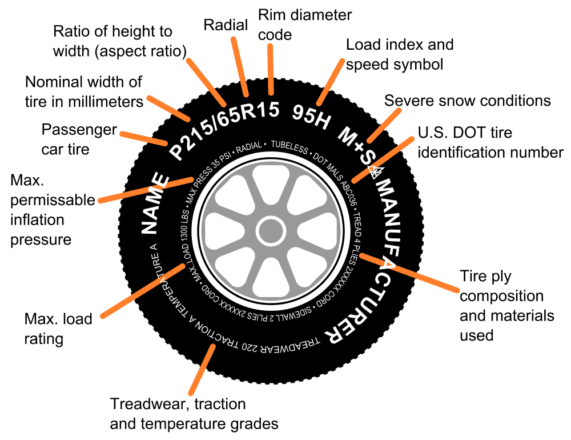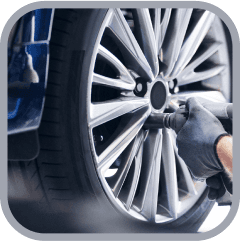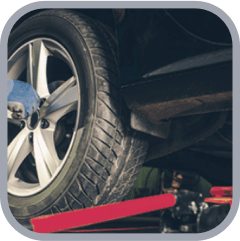AQS Help Centre
Question: How do I measure size of my tire?
For the quickest and easiest way to get your tire size and know that it will work for your vehicle is going to your current tires. On the sidewall of every tire there is a series of letters and numbers that make up the size of your tire. We advise getting the size from the tires currently on your vehicle to ensure you are shopping for the correct size. In many cases, such as for used vehicles, the wheels may not always by the stock part so the door panel which gives you the OEM size for the vehicle might possibly differ than what is currently on the vehicle.
For the quickest and easiest way to get your tire size and know that it will work for your vehicle is going to your current tires. On the sidewall of every tire there is a series of letters and numbers that make up the size of your tire. We advise getting the size from the tires currently on your vehicle to ensure you are shopping for the correct size. In many cases, such as for used vehicles, the wheels may not always by the stock part so the door panel which gives you the OEM size for the vehicle might possibly differ than what is currently on the vehicle.
TYPE : Commonly you may find the letter "P" at the beginning of the size information. For example, the letter "P" denotes that the tire is for a "Passenger Vehicle" meeting the standards for use in the United States, intended for Passenger vehicles.
WIDTH : This is the the tire width measured in millimeters from sidewall to sidewall. In this example, the tire is 225 millimeters wide from sidewall to sidewall.
ASPECT RATIO : This is the ratio of the height of the tire's cross-section to its width. The two-digit number after the slash mark in a tire size is the aspect ratio. For example, this P225/60R15 tire, the 60 denotes the height of the sidewall is 60% of the width of the tire.
CONSTRUCTION : The letter "R", common in most tires denotes that this tire's construction is "RADIAL" - a popular, reliable and very common construction type.
DIAMETER : Your tire's diameter is the size of the wheel it's intended to fit on, measured from one edge to the other. A size P225/60R15 tire is designed for a wheel with a 15" diameter.

Question: What are the wear and tear signs in a tire?
The rubber on your tires has been worn down and you are at risk of a tire blowout. Most states require you to have at least 2/32” of tread. You can find more information about tread depth here.
The rubber in your tires does not contain the moisture that it once did. This often occurs due to storage conditions, excess exposure to the sun, natural aging of the rubber, and other environmental factors. You can see what dry rot looks like in the photo below.
This is one of the most common types of tire failures. This occurs when the tire tread separates from the rest of the tire. You can sometimes spot early signs of this by looking for a wavy pattern in your treads - this is a sign that tread separation has begun.
There are many issues that can cause your car or truck to vibrate. Potential causes that can result in this type of problem include: suspension, alignment, and tire-related issues. If your car is vibrating while you drive, this can sometimes be a sign of tire damage or poor tire balancing, and you should have your tires & vehicle inspected.
This is an obvious sign that you are going to need a tire repair or a new tire. If you spot a nail sticking into your tire, it is best to take your car to a service center where they can repair or replace the tire.
If your tire is slowly leaking air, you should get the tire repaired or replaced immediately. It may be tempting to drive with a tire that is slowly leaking air, but it will begin to leak faster and faster in the coming weeks, and eventually the tire can fail. Deal with leaking tires quickly! Any of these abnormalities should be addressed. These problems will usually result from aging, weakening of the rubber, or failure of some of the internal elements of your tire.

Question: How do I install my new tires?
Before you head on over to a national tire dealer or new tire distributor, there is a good chance that they may not mount your tires for you. If shops are in the business of selling tires they may choose to only install their own and not the tires you bring to them. National retailers are in business to sell you tires directly and make profits. Even when they offer special deals like buy 3 tires and get the 4th one free, the total cost to you is still much higher than the savings you enjoy when buying high quality new tires. Thankfully TireMart.com gives you a full 90 Day Money Back Guarantee for the tires you buy, so you have nothing to worry about in the rare case there is an issue with a tire. Make sure to go to a professional, experienced installer for your tires. They will inspect each tire and ensure their safety for your vehicle. Check online to make sure they are reputable and customers have positive things to say about them and their service. So where do you go to have your new tires installed?
- Most local tire shops
- Gas stations
- Oil change centers
- Body shops
These service centers will install your new tires and high speed balance them. Prices are usually a bit cheaper at these local businesses so you’ll even same some extra cash by avoiding the larger chains. When you have your new tires installed, this process consists of several steps:
- Remove existing tires and disposal of them
- Mount your tires on your wheels
- Inflate them to the correct tire pressure
- High speed balance them
If you’re getting 4 tires installed, the entire process itself takes about 45 minutes. The real wait time depends more on how many vehicles are ahead of you and whether one or two guys work on your car together. If you’re going to have your wheels aligned as well, expect that to take another 45 minutes to one hour.




